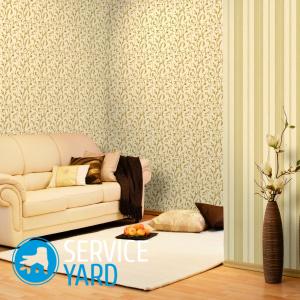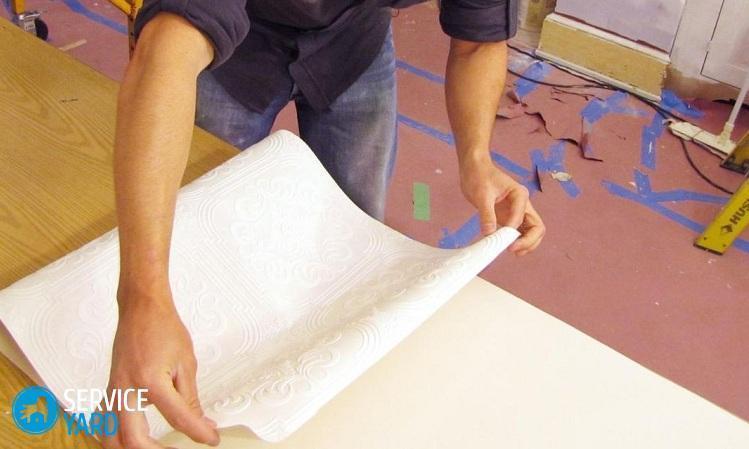How to glue the wallpaper butt?

Nowadays, repair is not only a simple arrangement of an apartment or house, many people want and try to use it to make their own corner, if not the best, then in any case not one of the worst, and here the first questions arise. How to prepare the surface before gluing? What kind of wallpaper are there? How to glue the wallpaper butt?
When sticking wallpaper with your own hands to achieve the best result, in the end, you must definitely adhere to the technology. Naturally, the final appearance of the walls will also depend on both the type of wallpaper and the surface on which they will be glued, as well as the temperature in the room and in the proper selection of glue. We will deal with all the nuances in detail in this article.
to contents ↑Wall preparation
Before gluing modern wallpapers, it is necessary to carefully prepare all surfaces before this.
Wall preparation process:
- Remove the old wallpaper from the walls very carefully, and those pieces that tear off very hard, pre-soak with water.
- Using gypsum plaster, plaster the walls along the lighthouses. This process is very important, it must be done in any room, whether it is a new building or secondary housing. The end result is smooth walls that are ideal for painting work.
- Next, wall the walls, which will hide the smallest bumps in the walls and roughness. Putty will also reduce glue consumption during work.
Important! A large amount of glue is absorbed by the plastered, but after this not plastered surfaces.
- The next step is a surface primer, which can be done with a deep penetration primer or with glue.
- At the end, treat the fungicidal mixture of the wall - this will prevent the appearance of the fungus.
Important! After drying the fungicidal mixture you have applied, the walls are completely ready for gluing.
Wall readiness check
To check if your surface is ready for the next step, take a small square of cellophane, and use a masking tape to fix it on the wall. After a day, check:
- if cellophane is dry - the surface is ready for further work;
- if perspiration appeared on cellophane, the wall has not dried out enough.
Preparation before wallpapering
After preparing the walls, choosing wallpaper and glue, it’s worthwhile to figure out how to properly glue wallpaper joint to joint. First you need to prepare all the tools you need.
Used materials and tools:
- Wallpaper.
- Wallpaper glue.
- A simple pencil.
- Building tape measure.
- Clerical knife.
- Wallpaper brush.
- A vessel for diluting glue.
- Roller.
- Putty knife.
- Sponge.
to contents ↑Important! Choose glue under the wallpaper very carefully. Consult the sales assistant or read on the packaging what type of adhesive is suitable.
Wallpapering
There are two options for gluing - overlap and joint to joint. The first option is used when gluing wallpaper in corners or other hard-to-reach places, and the second - in all other cases. To properly glue the butt-to-butt wallpaper, you need to follow the technology below.
Adhesive Technology:
- Cut the roll into canvases of the length you need, while adding about 5 cm.
- Spread the glue very carefully with a brush from the center to the edges of the strip.
Important! Do this carefully so that the glue mixture does not get on the front side of your wallpaper.
- After - fold the cut strip in half, leave it for a while so that it is saturated.
- Using a plumb line, put a vertical mark that will become a guideline for you to evenly adhere the first strip of the web soaked with glue.
- Glue the wallpaper. They should be glued from top to bottom from the corner of the room, which is located on the wall with a window according to the landmark you noted earlier.
- Now smooth the glued sheet with a spatula, and remove the excess adhesive mixture with a sponge. Press the joint firmly so that all the air “comes out” from the canvas and no bubbles form.
- Next, stick the next impregnated strip end-to-end to the previous one. The edges should form an invisible joint.
- Walk the seam roller over the joints after drying to prevent the edges from peeling off.
to contents ↑Important! Excess parts of the canvas should be trimmed only after complete drying. Use a sharp knife. The minimum temperature in the room should be 20 degrees, while the windows and doors are tightly closed.
Sticking different types of wallpaper
Let's look at how to glue a butt-to-butt wallpaper using different types of wallpapers.
Satin
Satin wallpaper is a very popular type of vinyl. They are produced by applying fabric fibers to a dense base. They are also called silk-screen printing:
- The first thing you need in your work is a special glue for satin wallpaper or just for heavy ones.
- The second prerequisite is gluing the paintings on a flat surface.
Next, we select the picture, cut the roll into strips and put marks on the wall. We apply glue only on the walls.
Paper
The market leader among building materials is paper wallpaper. There are several types of them - single-layer (simplex), two-layer relief (duplex) and heavy paper wallpaper.
The process of sticking paper canvases is very simple: it is worth choosing the right adhesive mixture, which is based on starch with antifungal additives, and then simply dilute it according to the instructions. Next, we cut the strips, apply glue, let it soak and stick to the surface.
Washable
Wallpaper, which is to some extent resistant to moisture, is called washable. Most often they are used in the kitchen and in the bathroom. They are washed very simply with a soft sponge.
Important! There are also types that can be washed using brushes and detergents.
You will need glue for heavy cloths. The wall should be smooth. The technology is no different from standard gluing.
Important! Self-adhesive washable wallpapers are now on sale. Gluing them is very simple - remove the protective film, attach it to the right place and slide it with a roller.
Liquid
Now in the top liquid wallpaper. In principle, this material is more like plaster, but after applying them to the wall and drying them completely, the wall feels soft to the touch and resembles wallpaper. They are glued very easily - following the instructions, dilute dry powder with water and, using a spatula, apply the finished mixture to the wall. To give a relief, use a special roller.
to contents ↑Stock footage
As it turned out, gluing the wallpaper butt is not so difficult. It is simply necessary to approach this in all seriousness and spend a lot of time, and as practice shows, sometimes even nerves, but the final result will exceed all your expectations. If you follow all the tips, your walls will be perfectly smooth and will look like a whole.
- How to choose a vacuum cleaner taking into account the characteristics of the house and coatings?
- What to look for when choosing a water delivery
- How to quickly create comfort at home - tips for housewives
- How to choose the perfect TV - useful tips
- What to look for when choosing blinds
- What should be running shoes?
- What useful things can you buy in a hardware store
- Iphone 11 pro max review
- Than iPhone is better than Android smartphones




